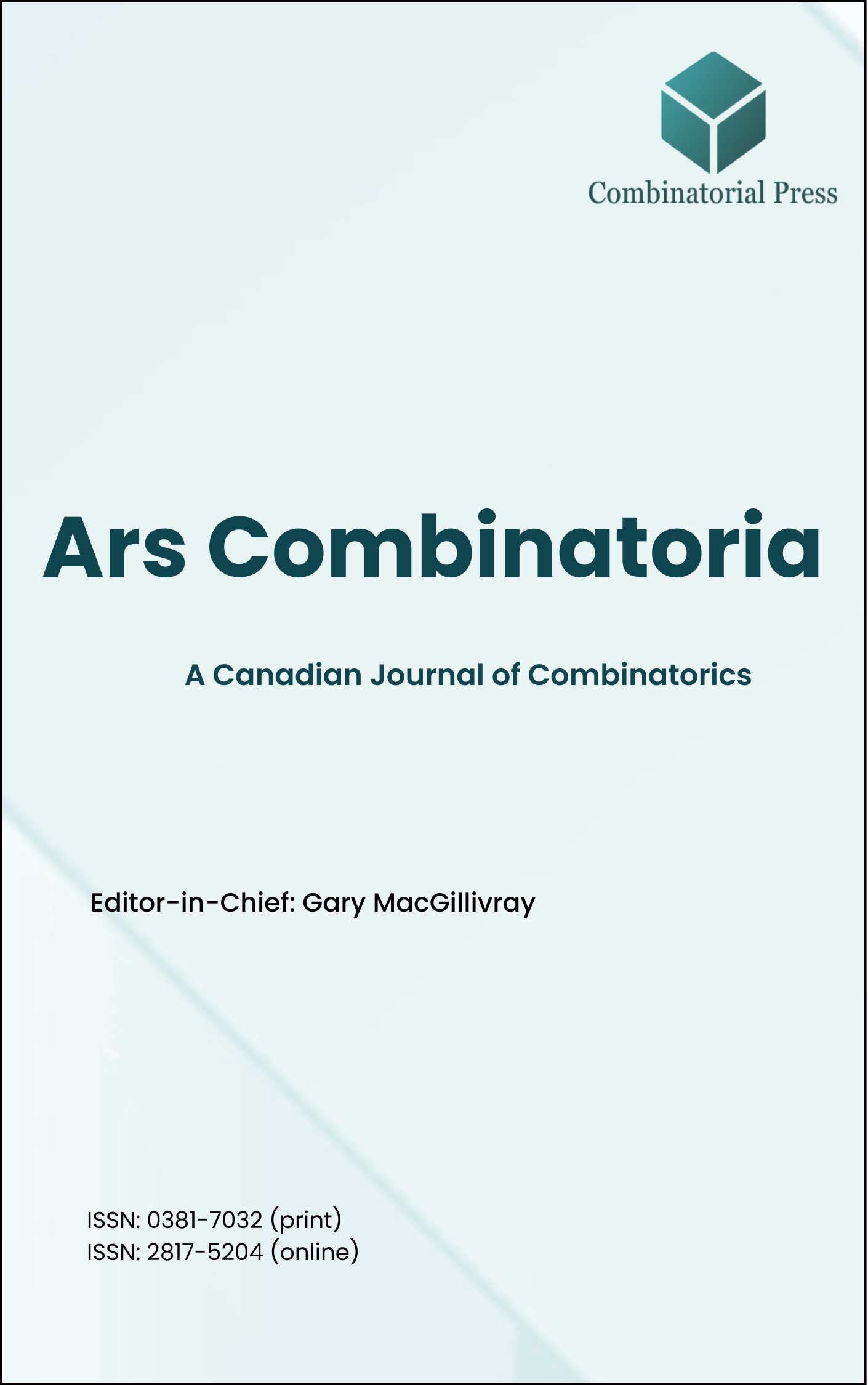
Ars Combinatoria
ISSN 0381-7032 (print), 2817-5204 (online)
Ars Combinatoria is the oldest Canadian Journal of Combinatorics, established in 1976. The journal is dedicated to advancing the field of combinatorial mathematics through the publication of high-quality research papers. From 2024 onward, it publishes four volumes per year in March, June, September and December. Ars Combinatoria has gained recognition and visibility in the academic community and is indexed in renowned databases such as MathSciNet, Zentralblatt, and Scopus. The Scope of the journal includes Graph theory, Design theory, Extremal combinatorics, Enumeration, Algebraic combinatorics, Combinatorial optimization, Ramsey theory, Automorphism groups, Coding theory, Finite geometries, Chemical graph theory but not limited.
Information Menu
- Research article
- Full Text
- Ars Combinatoria
- Volume 042
- Pages: 33-47
- Published: 30/04/1996
We present sufficient conditions for the existence of a \(k\)-factor in a simple graph depending on \(\sigma_2(G)\) and the neighbourhood of independent sets in our first theorem and on \(\sigma_2(G)\) and \(\alpha(G)\) in the second one.
- Research article
- Full Text
- Ars Combinatoria
- Volume 042
- Pages: 3-31
- Published: 30/04/1996
It is well known that a necessary condition for the existence of a \((v, 4, 1)\)-RPMD is \(v \equiv 0 \text{ or } 1 \pmod{4}\) and the existence of \((v, 4, 1)\)-RPMDs for \(v \equiv 1 \pmod{4}\) has been completely settled.
In this paper, we shall introduce the concept of \((v, k, 1)\)-nearly-RPMDs and use it to obtain some new construction methods for \((v, k, 1)\)-RPMDs with \(v \equiv 0 \pmod{k}\). As an application, we shall show that a \((v, 4, 1)\)-RPMD exists for all integers \(v \geq 4\) where \(v \equiv 0 \pmod{4}\), except for \(v = 4, 8\) and with at most \(49\) possible exceptions of which the largest is \(336\).
It is also well known that a \((v, k, 1)\)-RPMD exists for all sufficiently large \(v\) with \(k \geq 3\) and \(v \equiv 1 \pmod{k}\), and a \((v, k, 1)\)-PMD exists with \(v(v – 1) \equiv 0 \pmod{k}\) for the case when \(k\) is an odd prime and \(v\) is sufficiently large. In this paper, we shall show that there exists a \((v, k, 1)\)-RPMD for all sufficiently large \(v\) with \(v \equiv 0 \pmod{k}\), and there exists a \((v, k,\lambda)\)-PMD for all sufficiently large \(v\) with \(\lambda v(v – 1) \equiv 0 \pmod{k}\).
- Research article
- Full Text
- Ars Combinatoria
- Volume 041
- Pages: 311-317
- Published: 31/12/1995
In this paper we have investigated harmonious labelings of \(p\)-stars, where a \(p\)-star of length \(x\) is a star tree in which each edge is a path of length \(k\). We have also demonstrated an application of the labelings to \(k\) disjoint \(p\)-cycles.
- Research article
- Full Text
- Ars Combinatoria
- Volume 041
- Pages: 302-310
- Published: 31/12/1995
We show that if a graph \(G\) has \(n\) non-isomorphic \(2\)-vertex deleted subgraphs then \(G\) has at most \(n\) distinct degrees. In addition, we prove that if \(G\) has \(3\) non-isomorphic \(3\)-vertex deleted subgraphs then \(G\) has at most \(3\) different degrees.
- Research article
- Full Text
- Ars Combinatoria
- Volume 041
- Pages: 289-301
- Published: 31/12/1995
Observability of a graph is the least \(k\) admitting a proper coloring of its edges by \(k\) colors in such a way that each vertex is identifiable by the set of colors of its incident edges. It is shown that for \(p \geq 3\) and \(q \geq 2\) the complete \(p\)-partite graph with all parts of cardinality \(q\) has observability \((p-1)q+2\).
- Research article
- Full Text
- Ars Combinatoria
- Volume 041
- Pages: 278-288
- Published: 31/12/1995
Let \(V\) be a finite set of order \(\nu\). A \((\nu,\kappa,\lambda)\) packing design of index \(\lambda\) and block size \(\kappa\) is a collection of \(\kappa\)-element subsets, called blocks, such that every \(2\)-subset of \(V\) occurs in at most \(\lambda\) blocks. The packing problem is to determine the maximum number of blocks, \(\sigma(\nu,\kappa,\lambda)\), in a packing design. It is well known that \(\sigma(\nu,\kappa,\lambda) < \left[ \frac{\nu}{\kappa}[\frac{(\nu-1)}{\kappa(\kappa-1)}] \right] = \psi(\nu,\kappa,\lambda)\), where \([x]\) is the largest integer satisfying \(x \ge [x]\). It is shown here that if \(v \equiv 2 \pmod{4}\) and \(\nu \geq 6\) then \(\sigma(\nu,5,3) = \psi(\nu,5,3)\) with the possible exception of \(v = 38\).
- Research article
- Full Text
- Ars Combinatoria
- Volume 041
- Pages: 269-277
- Published: 31/12/1995
In this paper we obtain some new relations on generalized exponents of primitive matrices. Hence the multiexponent of primitive tournament matrices are evaluated.
- Research article
- Full Text
- Ars Combinatoria
- Volume 041
- Pages: 257-268
- Published: 31/12/1995
The ranking and unranking problem of a Gray code \(C(n,k)\) for compositions of \(n\) into \(k\) parts is solved. This means that rules have been derived by which one can calculate in a non-recursive way the index of a given codeword, and vice versa, determine the codeword with a given index. A number system in terms of binomial coefficients is presented to formulate these rules.
- Research article
- Full Text
- Ars Combinatoria
- Volume 041
- Pages: 247-256
- Published: 31/12/1995
In the definition of local connectivity, the neighbourhood of a vertex consists of the induced subgraph of all vertices at distance one from the vertex. In {[2]}, we introduced the concept of distance-\(n\) connectivity in which the distance-\(n\) neighbourhood of a vertex consists of the induced subgraph of all vertices at distance less or equal to \(n\) from that vertex. In this paper we present Menger-type results for graphs whose distance-\(n\) neighbourhoods are all \(k\)-connected, \(n \geq 1\).
- Research article
- Full Text
- Ars Combinatoria
- Volume 041
- Pages: 240-246
- Published: 31/12/1995
A partially ordered set \(P\) is called a circle order if one can assign to each element \(a \in P\) a circular disk in the plane \({C_a}\), so that \(a < b\) iff \(C_a \subset C_b\). It is known that the dual of every finite circle order is a circle order. We show that this is false for infinite circle orders.





